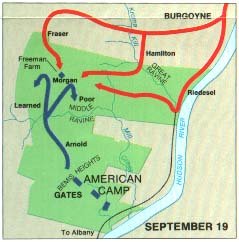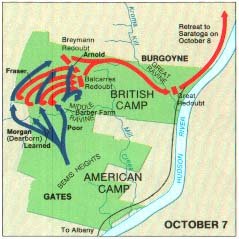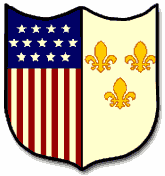Battle of SaratogaIn 1777, British war generals devised a plan to bring a quick end to the war: They would effectively sever New England from the rest of the colonies by taking control of New York City, Albany, and the Hudson River. First, British General John Burgoyne would lead 8,000 troops from Canada. Barry St. Leger would direct his troops east from Lake Ontario, and General Howe would move his troops north from New York City, where all three would meet at Albany to destroy the Rebel armies.
General Howe, however, had different plans. Howe brought his army south from New York and invaded the Patriot capital of Philadelphia. Although he succeeded in capturing the city and forcing Congress to flee to York, Pennsylvania, he decided to camp his army in the capital for the winter, rather than proceeding with the plan and marching to Albany. Furthermore, stubborn Patriot resistance under the infamous General Benedict Arnold kept St. Leger from making it to Albany, and Burgoyne’s progress was slowed by excess baggage and entire groves of trees felled by the Patriots to make his travels even more difficult. Slow on supplies, Burgoyne sent a detachment to capture an American supply base at Bennington, Vermont. The detachment was defeated by John Stark and the Green Mountain Boys, causing Burgoyne to withdraw to Saratoga, N.Y. Burgoyne’s army soon became trapped in Saratoga, blocked in the south by Patriot General Horatio Gates’ army. Howe’s army remained in Philadelphia, and St. Leger’s Army was defeated at Fort Stanwix. On October 7, 1777, Burgoyne made a desperate attempt to attack the larger Patriot force at Saratoga which now comprised the armies of both Gates and Arnold. Despite initial success at Freeman’s Farm, Burgoyne’s Army would be routed by Arnold’s at Bemis Heights. Beset by a lack of supplies and horrendous casualties, Burgoyne had no choice but to surrender. The Patriot victory at Saratoga is often seen as the turning point in the war. Not only did it renew the morale of the American public, but it convinced potential foreign partners, such as France, that American could win the war, and that it might be in their best interests to send aid. In February of 1778, with the help of Benjamin Franklin and his charisma while Minister to France, the United States and France signed a treaty of alliance. As a result, France sent generals, troops, ships, supplies, and money to America to help in the war effort. France declared war on England. Spain would declare war on England in 1779.
|
|||
|---|---|---|---|








